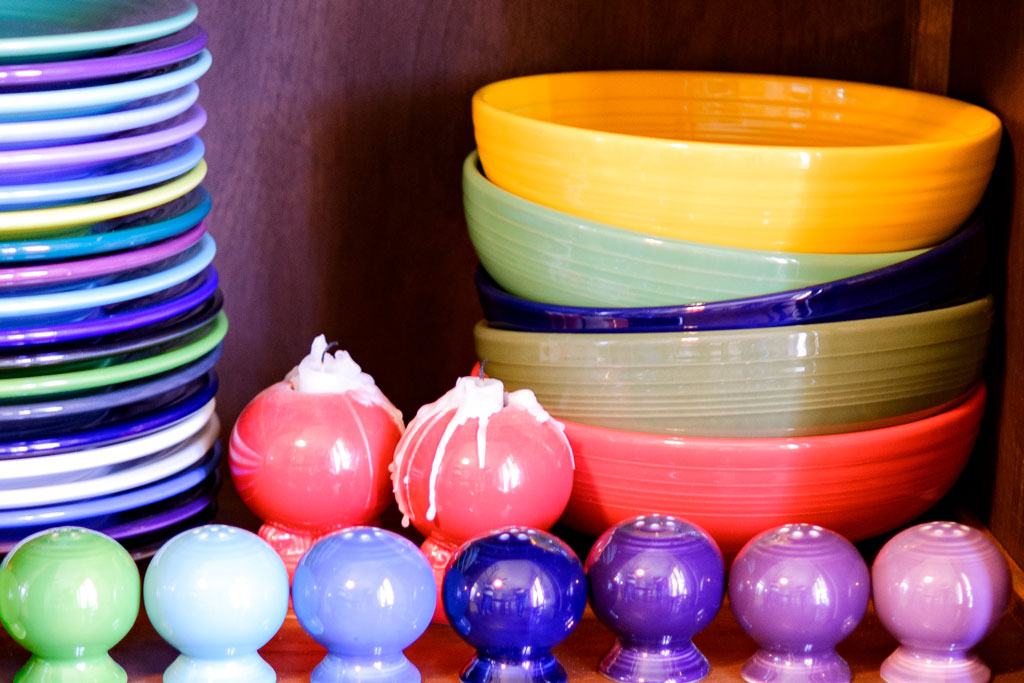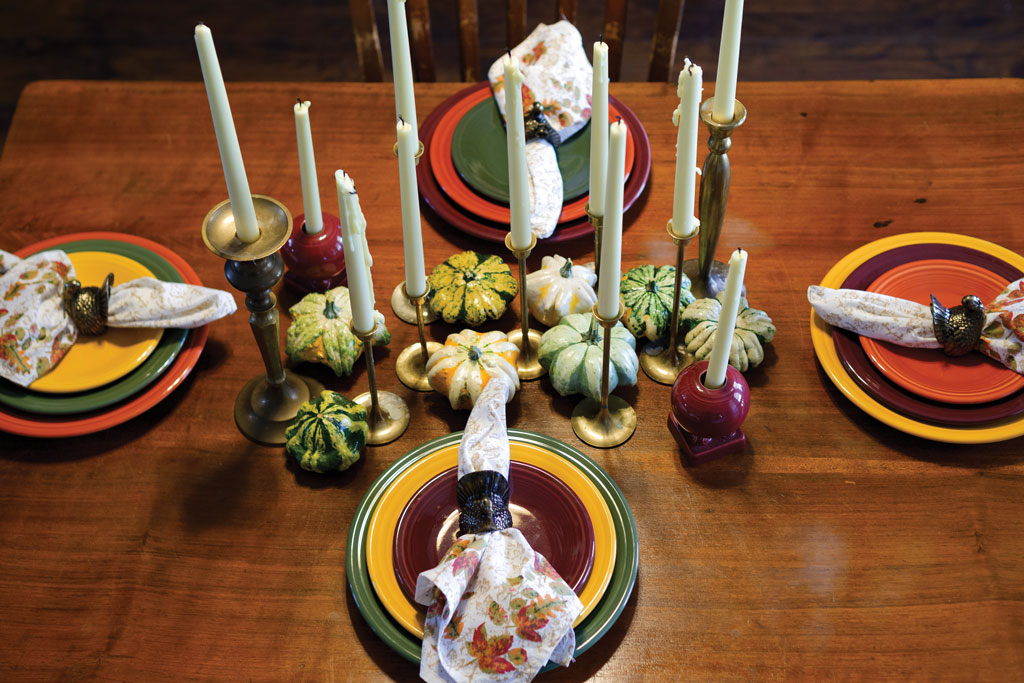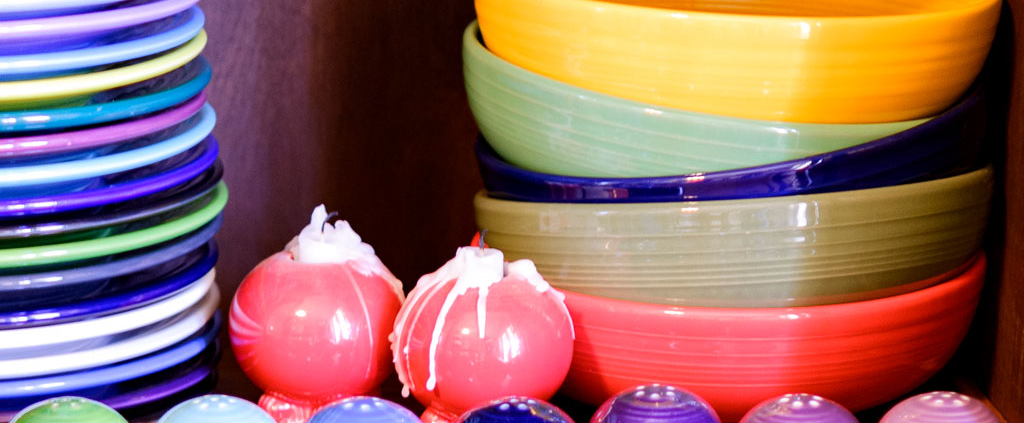Picayune People: It’s always a Fiestaware day for collector Kimberlee McLeod
(Story written by correspondent Shirlene Bridgewater)
For Burnet resident Kimberlee Allen McLeod’s family, Thanksgiving dinner pops with color. A second-generation collector of Fiestaware, McLeod carefully packs selected pieces, all color coordinated, for holiday dinner at her mother’s house.
Introduced to the United States in 1936 by the Homer Laughlin China Company, Fiestaware is “An American Icon” — the company’s tagline — and includes plates, bowls, pitchers, vases, platters, and other pieces in more than 50 colors and used to serve everything from breakfast to a feast.
“It’s now fun to unload the dishwasher,” McLeod said. “Fiestaware is just so happy.”
During and immediately after the Great Depression in the 1930s, Fiestaware collectors had the same sentiment. In “Fiesta: Then and Now,” an article on the company’s blog, then-President Joseph M. Wells Sr., declared: “People need to brighten up their table and need something to be happy about. Color is what’s going be good for the Depression.” Sales hit the roof.
McLeod agreed with the need to feel joy.
“Recently, the COVID-19 pandemic has turned the world upside down. We’ve all experienced radical adjustments in our lives,” she said. “Isolation, loss of loved ones, and changing workplaces have created fear, anger, and loneliness like never before in recent times, and we need something to feel happy about.”
McLeod is a longtime Fiestaware collector. She started her contemporary and vintage collection in 2007 when she moved into her first apartment near Texas A&M University, where she majored in English. At the same time, she started going on antiquing trips with her mother, aunt, and godmother to search for the colorful dishware.
“The thrill of the hunt” excites her.
“Who knows, I might even run into Whoopi Goldberg or Martha Stewart, who have been rumored to be Fiestaware fans,” she said.

Through the years, McLeod has learned the history of Fiestaware, its original colors, lines, and shapes, and how to distinguish the “real deal” from the fakes. She’s purchased from thrift and discount stores, estate sales, online dealers, Facebook Marketplace, and even out of the trunk of a car in a mall parking lot.
“There’s monetary value in vintage pieces, rarer shapes and colors, and exclusive decals,” McLeod said. “You could be sitting on a gold mine with pieces skyrocketing to the five-figure range.”
Originally, a place setting for eight retailed at $14.95.
McLeod’s collection is extensive, although she no longer counts how many pieces she owns. Instead, she records what she has in each color, where and when she bought it, how much she paid, and if she’s sold a piece.
Wherever she goes, McLeod’s keen eyes can spot Fiestaware. On a trip to Scotland with her husband in 2018, she ventured into a small, quaint antique shop in Edinburgh in search of a vintage elephant, another treasure she hunts.
In conveying the story, she gazes off and she is once again in that medieval town among gardens and neoclassical buildings.
“I turned around and looked up and ran to grab an evergreen pitcher high on a shelf,” she said.
The guy behind the counter said to her in his Scottish brogue, “Do you know what that is?”
McLeod challenged him.
“Do you know what this is?” she said. “This is American. What is it doing here?”
She learned the store owner had purchased someone’s estate collection that they didn’t want to ship back to the U.S. when they left Scotland.
“I bought the pitcher for 20 pounds, and that sticker is never coming off!” she said with joyful conviction.
This special piece joins her other Fiestaware treasures, especially those in her favorite colors: lilac and marigold.
“They’re harder to find, more expensive, and gorgeous,” she said of the colors.
McLeod’s least favorite is apricot.
“Who needs flesh-colored dishes?” she said.
In recent times, this take-charge high school English teacher created a thriving Instagram community — @captainfiesta2016 — with nearly 1,200 followers from East Coast to West Coast and even Canada, Nova Scotia, and England.
“The Fiesta IG community is fun and such a lifesaver,” McLeod said. “When there are fires, floods, and other natural disasters, as well as health challenges for members, the community sends prayers and cards and helps replace pieces of lost collections.”

Even when McLeod had the “Big Fall” — the time she lost 16 pieces of retired colors after a shelf collapsed — a friend came to the rescue. He skillfully built the two glass-and-oak cabinets that now store some of her collectibles.
“He stood on each shelf to make sure they could withstand more than 150 pounds,” she said.
The Instagram community sent pieces to replace what she lost.
“It’s such a sweet comfort that we share with each other,” she said.
One IG community member also assisted McLeod when she received a shipment of rare, footed salad bowls, all broken. She learned she could create a new work of art by gluing the broken pieces together with gold, a technique from the Japanese called lintsugi, and it made “beauty from the broken.”
In her kitchen, McLeod uses her Fiestaware daily. She mixes and matches the colors to create a picnic tablescape or a setting fit for “fajitas for the King of England and his entourage.” It’s definitely “a collection of love and one full of memories.”
The next step in McLeod’s crockery adventures is to visit the Fiestaware factory in Newell, West Virginia, where the dinnerware has been made since its American introduction. A tour includes a stop at the museum, which houses displays from the dinnerware’s history.
McLeod would also like to attend the Homer Laughlin China Collectors Association annual summer convention. Named after the creator of Fiestaware, the association is a nonprofit organization that hosts workshops, auctions, exhibits, sales, and networking events for collectors.
Until then, McLeod will continue to host her Instagram Fiestaware photo challenge each March, scope out the dinnerware in movies and TV shows, and help those in her community as she prepares to set an especially colorful table for her family Thanksgiving.
“Who would have thought that colorful dishes could bring people together?” she said. “For that, I am grateful.”









Leave a Reply
Want to join the discussion?Feel free to contribute!